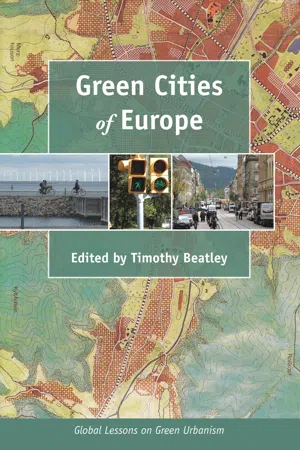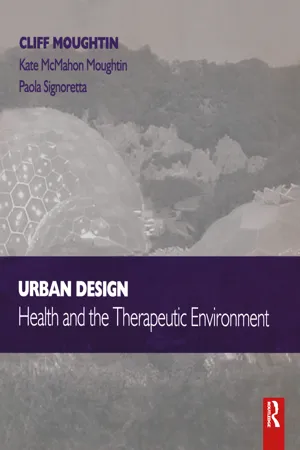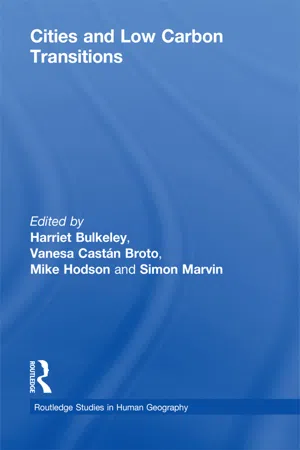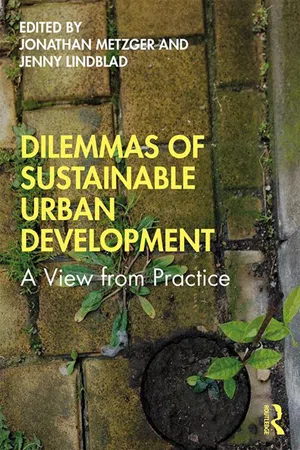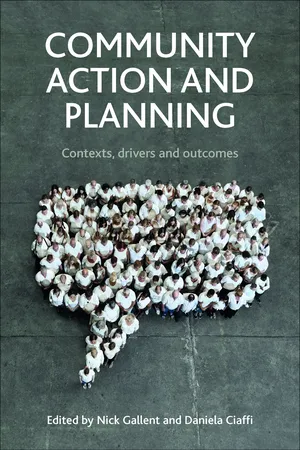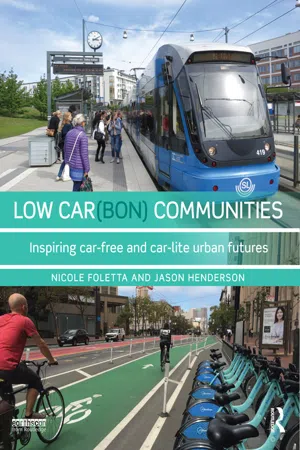Geography
Freiburg Case Study
The Freiburg Case Study is a well-known example of sustainable urban development in Germany. It focuses on the city of Freiburg, which has implemented various environmentally friendly initiatives such as sustainable transportation, energy-efficient buildings, and green spaces. The case study serves as a model for other cities seeking to achieve sustainable development and reduce their environmental impact.
Written by Perlego with AI-assistance
Related key terms
Related key terms
1 of 4
Related key terms
1 of 3
7 Key excerpts on "Freiburg Case Study"
- eBook - ePub
Green Cities of Europe
Global Lessons on Green Urbanism
- Timothy Beatley, Timothy Beatley(Authors)
- 2012(Publication Date)
- Island Press(Publisher)
3Freiburg, Germany: Germany’s Eco-Capital
Dale Medearis and Wulf DasekingNestled in the southern corner of Germany near the Swiss and French borders, the city of Freiburg has long been considered a model of sustainable development for Europe and the world (see table 3.1 ). Freiburg is a moderate-sized city of approximately 220,000 people, with a unique combination of topography, climate, leadership, and history that have merged to make it a pioneer in renewable energy (especially solar), nature protection, transportation, and environmental planning. Freiburg’s proliferation of renewable energy industries, clearly defined landscape plans and urban forests, vibrant public transportation system, and environmentally designed housing in projects in Rieselfeld, Wiehre Bahnhof, and Vauban reflect how environmental protection, economic growth, and social inclusion policies are not mutually exclusive, but interrelated. Freiburg’s success can be more appreciated when one considers that it has sustained steady and continuous population growth for over thirty years.Freiburg is recognized as a global leader in sustainable development when measured by comprehensive energy planning, water conservation, or high transportation modal splits. The city’s success in merging design, transportation, and ecology is reflected in its expanding trophy case of European and global sustainability awards, and is living proof that sustainable planning is moving from the margins to the mainstream.General Background and Profile
Freiburg’s success with environmental planning proves that ambitious environmental, energy, and nature-protection initiatives are economic development opportunities rather than insufferable obstacles. Three key elements have made Freiburg a pioneer in this realm: the city’s utilization of its comparative advantage with the relatively high concentration of sunlight, its rural isolation at the base of the Black Forest, and its development of a comprehensive energy program. - Paola Signoretta, Kate McMahon Moughtin, J.C. Moughtin(Authors)
- 2009(Publication Date)
- Routledge(Publisher)
The Solar City of Freiburg 14
DOI: 10.4324/9780080885377-19Introduction
Germany has been chosen for this final case study because it is so far in advance of the UK in the reduction of its ecological footprint and therefore in its efforts to protect the environment that sustains health and well-being. It also has a health service and standard of living that is the envy of the world. While we in the UK produce a mere 2 per cent of energy from renewable sources, Germany produces 16 per cent. While we contemplate the building of a handful of eco-towns and eco-villages, some by 2016, Germany, starting from its existing urban structures, is developing eco-cities throughout the country. Freiburg has been chosen as a case study because it is an average kind of German city, about the size of Nottingham. It has been innovative in its approach to energy production, but it is no longer the leader in this endeavour: for that purpose Munich would have been chosen for the case study. Freiburg has also been chosen because it has developed two outstanding examples of new city quarters in Vauban and Rieselfeld: they are thoroughly modern garden cities fit for twenty-first century living.Financial Structures for Healthy Sustainable Development
The key to German success in this field of renewable energy production is a policy that empowers people and local authorities to solve energy problems for themselves. This citizen empowerment is the result of the German government’s decision to require energy companies to pay citizens four times the market price for solar energy that they produce themselves: it is a price that is guaranteed for 20 years. It is similar for gas: two years ago, the German government changed its rules on gas production, permitting locally produced biogas being fed into the gas network. However, it is only non-food crops, grown between food-crop seasons, which can be used for this energy source.- eBook - ePub
- Harriet Bulkeley, Vanesa Castán Broto, Mike Hodson, Simon Marvin(Authors)
- 2010(Publication Date)
- Routledge(Publisher)
First, we draw on our own experiences as commentators and participants in the political debates about energy in Graz (H.R. from 1988) and Freiburg (P.S. from 1997). Additionally, we conducted a series of interviews in 2009 with major players and critics of these policies and discourses. 1 In order to triangulate our perceptions and findings, we conducted a brief analysis of press coverage on this topic (local and national newspapers and the municipalities’ bulletins). 2 In the second section, we discuss the case of Freiburg and contrast it with findings from Graz, which are presented in the third section. In the fourth section of the chapter, we derive some tentative generalizations with regard to the role of urban discourses and social dynamics in socio-technical transitions resulting from the interaction of niches, regimes and a broader socio-technical landscape. We conclude with a summary and a note of caution concerning the ambition to manage processes similar to those analysed. The case of Freiburg The city of Freiburg has approximately 220,000 inhabitants and is located in the south-western corner of Germany. It is surrounded by the slopes of the Black Forest to the east and the upper Rhine valley to the west. It serves the region as an administrative and commercial centre and is characterized by an old university, limited industry and a highly service-oriented economy. Since the early 1990s, Freiburg has been praised by its inhabitants and visitors not only for its outstanding living quality but also for a set of remarkable environmental policies. The city has also received several awards (for further details, see Hagemann 2007: background section; Filtnib 2007; Hopwood 2007). Freiburg brands itself today ‘the Green City’, on the basis of a long history of pioneering solar energy and environmental policies - eBook - ePub
Dilemmas of Sustainable Urban Development
A View from Practice
- Jonathan Metzger, Jenny Lindblad, Jonathan Metzger, Jenny Lindblad(Authors)
- 2020(Publication Date)
- Routledge(Publisher)
While Freiburg continues to uphold its sustainability agenda in the city, including developing sustainable neighborhoods, institutionalizing strict low energy standards, improving the tram network within the city, and supporting more sustainable lifestyles, supported by a vigorous branding and marketing program, meanwhile, in the hinterland, towns and cities such as Münster continue to cling on to the dream of living in suburbia, with its (semi)-detached single-family housing, car dependency, social homogenization, and daily commute to the green city. While at the first glance, Freiburg might appear as a green island in an ocean of unsustainability, families are in fact quitting the city and moving into the hinterland because they can no longer afford the cost of living and high house prices in Freiburg. The hinterland communities benefit from the economic downsides of living in the green city, and welcome these middle-class ‘renegades’ who have been ‘displaced’ by Freiburg’s sustainability agenda: those citizens, who are in search of relatively affordable housing or who are willing to spend more on larger plots than on strict energy regulations (for an interview with Mayor Endingen, see Miller & Mössner, forthcoming). The lack of regional governance and the non-existence of any serious regional planning cooperation between the green city and the surrounding municipalities is explained by the mayor of a smaller municipality in the Black Forest, located approximately 25 km from Freiburg: “The green city Freiburg ends where the train ends” (city planner, 2018, authors’ translation). This smaller municipality is de facto excluded from the regional public transportation network.The academic literature and countless expert groups who visit Freiburg or Münster rarely recognize the regional context, namely the city’s relationship with its hinterland. Despite researchers’ blindness to this reality, there are interesting relationships that need to be addressed in order to fully understand Freiburg’s sustainability agenda. The dominating focus on the city itself that leads sustainability research comes with a desperate hunt for the best practices that are required in order to find ostensibly better solutions that might transform our cities into more sustainable places (Roseland, 1997). We argue in this chapter that this search for best practices is highly problematic. It overlooks spatial contexts and ignores the complexity of urban development. And while it is still tempting for politicians and those who are looking for quick and easy solutions, one should act with caution when declaring that a city has adopted best practices. - eBook - ePub
Leading the Inclusive City
Place-Based Innovation for a Bounded Planet
- Hambleton, Robin(Authors)
- 2014(Publication Date)
- Policy Press(Publisher)
Finally, community leaders operating at the grassroots are critical in the governance of Freiburg. Without the drive and energy of community-based activists it is difficult to see how significant change could have been brought about.Leadership lessons- The Freiburg story illustrates the value of having strong, independent local government. Local authorities in Germany enjoy constitutional protection. Local leaders, unconstrained by centrally imposed performance indicators, have developed a forward looking strategy and delivered on it.
- The community activism in the neighbourhoods within Freiburg is the key driving force behind the success of the city in becoming a world leader in relation to environmental awareness and action. The commitment to green values and collective purpose is highly developed, and this external grassroots pressure ensures year-on-year improvements in environmental performance.
- The officers and professionals appointed by the city to push at the boundaries of good practice have played a crucial role. Those involved in city planning, transport planning and urban design deserve to be recognised for their high quality contribution alongside the other professionals working for the City Council.
- Successive elected mayors and elected councillors have promoted ambitious thinking in the city, and their consistent commitment to green values coupled with an enthusiasm for trying out new approaches has set the tone for adventurous urban innovation.
Academy of Urbanism and Stadt Freiburg, 2012, The Freiburg Charter for Sustainable Urbanism , 2nd edition, London: Academy of UrbanismHall, P, 2013, Good Cities, Better Lives. How Europe discovered the lost art of urbanism - eBook - ePub
Community Action and Planning
Contexts, Drivers and Outcomes
- Gallent, Nick, Ciaffi, Daniela(Authors)
- 2014(Publication Date)
- Policy Press(Publisher)
Chapter 10 , this volume). Theoretically, neighbourhoods could be empowered to deliver Vaubanstyle simplified planning arrangements, allowing residents freedom of physical expression, as long as such arrangements are broadly consistent with higher plans, as is also the case in Freiburg. The second is a modicum of support for the self-build sector, including for collaborative schemes, in apparent recognition of the financial, tangible and social rewards that the alternative models to volume house production may bring. Vauban has caught the attention of practitioners and policy makers internationally (Hall, 2013), and although the scheme’s evolution pertains in large part to local societal context and political circumstances, it illustrates the potential of community power under an enabling governance framework. Moreover, the social outcomes described in this chapter evidence the enduring social outcomes of this apparently radical but arguably instinctive approach to residential development.Notes
1 The site did not have planning permission and the municipal government indicated that they would not give permission to a developer. In effect the state had no choice but to sell to the city.2 Children tend to act as a social bridge: parents get to know one another through schools.References
Buehler, R, Pucher, J, 2011, Sustainable transport in Freiburg: Lessons from Germany’s environmental capital, International Journal of Sustainable Transportation 5, 1, 43–70Buehler, R, Jungjohann, A, Keeley, M, Mehling, M, 2011, How Germany became Europe’s Green leader: A look at four decades of sustainable policymaking, The Solutions Journal 2, 5, OnlineCity of Freiburg, 2007, Die Neubaugebiete Rieselfeld und Vauban [The New Developments of Rieselfeld and Vauban], Freiburg: City of FreiburgCity of Freiburg, 2012, Demographischer Wandel in den Freiburger Stadtbezirken [Demographic Profiles in Freiburg’s Districts], Freiburg: City of FreiburgDaseking, W, 2010, The sustainable suburbs of Vauban and Rieselfeld, unpublished paper, Freiburg, City of Freiburg Department for Building ConstructionHall, P, 2013, Good cities, better lives, London: RoutledgeHamiduddin, I, 2013, The social implications of residential car reduction: Exploring community and mobility at the neighbourhood scale, unpublished PhD thesis, University College LondonHamiduddin, I, 2014a, Social sustainability and neighbourhood form: Learning from the evolution of residential design in Freiburg, Germany, Town Planning Review - eBook - ePub
Low Car(bon) Communities
Inspiring car-free and car-lite urban futures
- Nicole Foletta(Author)
- 2016(Publication Date)
- Routledge(Publisher)
Conference on Sustainable Planning and Development , Dorset: WIT, pp. 701–720.- “Quartier Vauban” (2014) City of Freiburg : www.freiburg.de/pb/site/Freiburg/get/647919/Infotafeln_Vauban_en.pdf.
- R+T (1999) Verkehrsentwicklungsplan Freiburg. Teil A: Problemanalyse , Freiburg: R+T.
- Scheurer, J. (2001) Urban Ecology, Innovations in Housing Policy and the Future of Cities: Towards Sustainability in Neighbourhood Communities , Perth: Murdoch University Institute of Sustainable Transport.
- Sommer, U. and Wiechert, C. (2014) “Lernen von Vauban. Ein Studienprojekt und mehr ,” Architecture Department, RWTH Aachen University, Aachen, Germany.
- Umweltbundesamt (2009) Daten zum Verkehr. Ausgabe 2009 , Umweltbundesamt, Dessau-Roßlau.
- URBED: www.urbed.com/ .
- VAG Freiburg (municipal transit operator): www.vag-freiburg.de/
Index pages curate the most relevant extracts from our library of academic textbooks. They’ve been created using an in-house natural language model (NLM), each adding context and meaning to key research topics.
Explore more topic indexes
Explore more topic indexes
1 of 6
Explore more topic indexes
1 of 4
